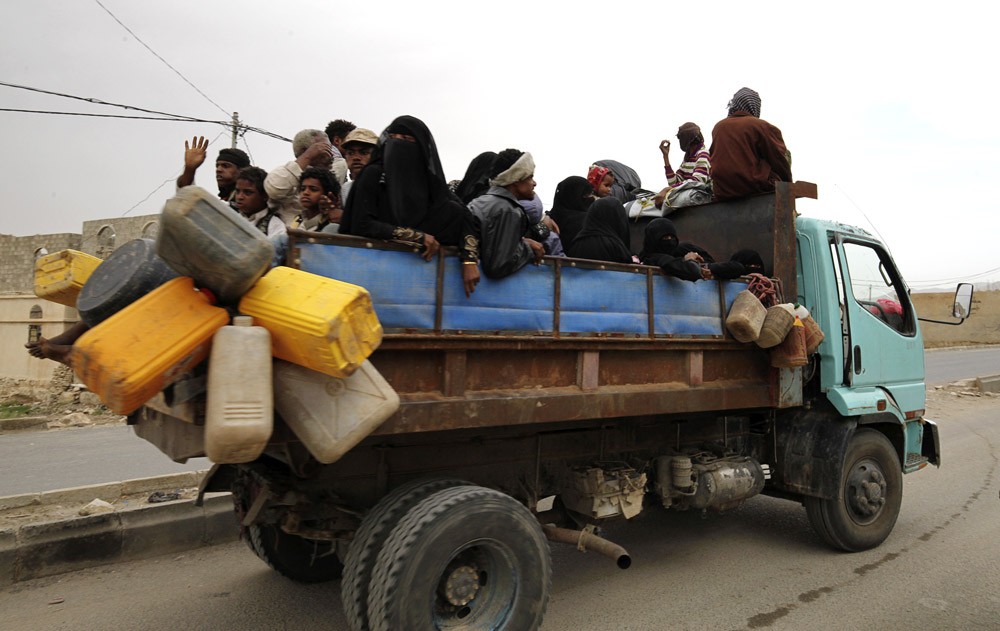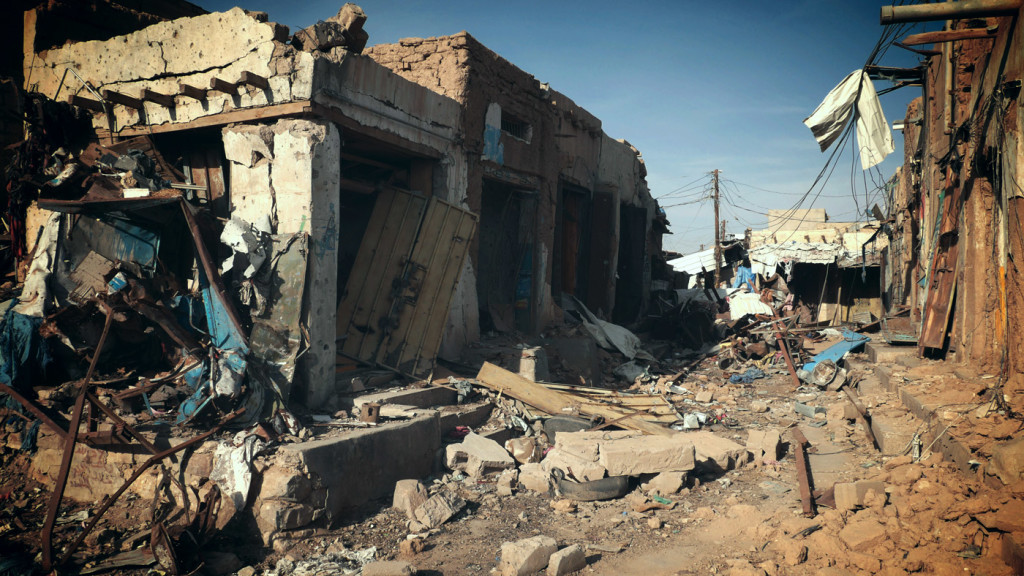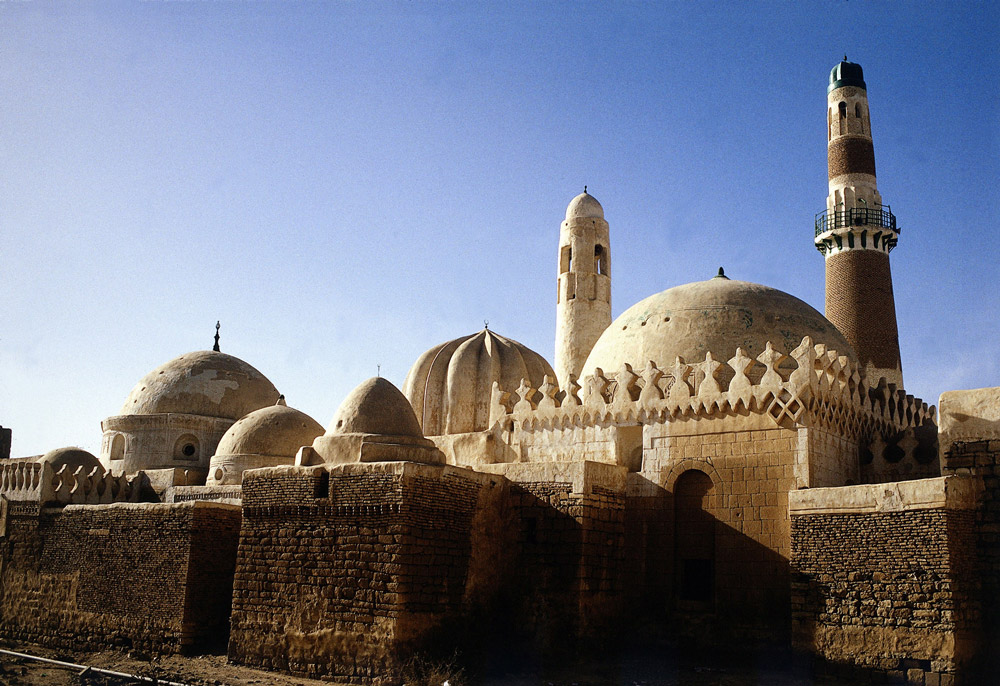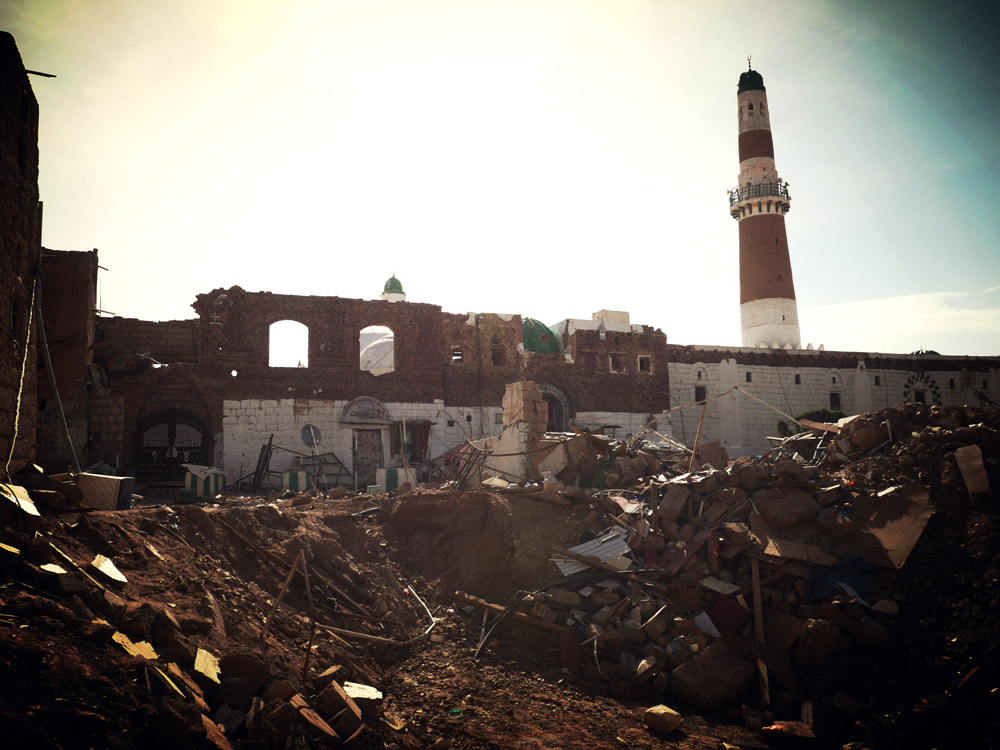The Agony of Saada: U.S. and Saudi Bombs Target Yemen’s Ancient Heritage
MIDDLE EAST AND NORTH AFRICA, 17 Nov 2015
16 Nov 2015 – Shards of blue, red, and green stained glass, remnants of an intricate crescent window that is a 4,000-year-old Yemeni art form, glitter in the sunlight before crunching underfoot. Atop a mound of dust and mud stands the shell of an ancient tower-house, sliced in half like a cake by an airstrike.
In addition to the growing number of civilian casualties in the country’s seven-month-long war, U.S.-made bombs dropped by fighter jets from a Saudi Arabian-led coalition are pulverizing Yemen’s architectural history, often referred to as a living museum. These airstrikes are tearing villages apart, forcibly displacing thousands and erasing the country’s inimitable heritage, possibly in violation of international humanitarian law, according to the world heritage body, UNESCO.
Entire villages in the Yemeni highlands appear to defy gravity. Remote high-rises cling precariously to cliff edges. Inside, the character of the fortress-like homes changes with the sun as it moves through the sky. Light filters through the stained glass of patterned windowpanes, called qamarias, illuminating the white gypsum plaster. At night, candles or rare supplies of electricity send dapples of color into the twilight.
Yemen’s time-honored homes are part of the country’s rich social fabric, embodying the culture of the families who have lived in them for centuries. The Middle East’s poorest nation is famous for constructing the world’s first skyscrapers, often up to 100 feet high, with as many as 11 stories designed to keep extended families and their livestock safely under one roof.
The violent assault on the country’s history over the past seven months began in March after a political power struggle between incumbent president Abdu Rabbu Mansour Hadi and Houthi rebels backed by soldiers loyal to the former president, Ali Abdullah Saleh, descended into civil war.
But Yemen’s internal conflict has also landed the country’s 26 million people in the middle of the regional struggle between Sunni Saudi Arabia and Shiite Iran, already at loggerheads over the war in Syria. After the predominantly Shiite Houthi rebels seized control of the capital, Sanaa, last year, Saudi Arabia and a coalition of nations supported by the United States launched an unrelenting aerial bombing campaign. There have been near-daily air raids ever since.
The Saudis say they intervened in Yemen for two reasons: to restore the Hadi government forced into exile by Saleh’s loyalists in the military collaborating with the Houthis, who they claim are an Iranian proxy, and to counter what they view as a growing threat by Iran to seize power and influence in the region. The level of Tehran’s support, however, is disputed.
At least 5,604 people, including 2,577 civilians, have died since the conflict began in March, according to a United Nations tally of figures from local health facilities. That number is probably an undercount of the real figure, because many of the dead or injured never reach medical treatment centers and bodies are often buried unrecorded.
A joint report by the U.K.-based charity Action on Armed Violence and the United Nations’ Office for the Coordination of Humanitarian Affairs concluded that airstrikes were responsible for 60 percent of civilian casualties in the first seven months of this year.
One of the worst hit areas has been Yemen’s northern province of Saada, the birthplace and homeland of the Houthi movement. Saada City, the provincial capital, was founded before the fourth century B.C., as the hub of the Minaean Kingdom of Main.
On May 8 the Saudi-led coalition declared Saada City, home to some 50,000 people, a “military zone,” which Human Rights Watch says is a clear violation of international humanitarian law, and gave civilians a few hours’ notice to leave.
Many of those who did not heed the coalition’s warning were forced to flee their homes by the ensuing airstrikes. The village of Rahban, on the outskirts of the city, was razed. It consisted entirely of historic, centuries-old multistory homes with thick rammed-earth walls, rainbow-colored stained-glass windows and hand-carved wooden doors. Timber joists that supported families for tens of generations now protrude from piles of rubble. More than 30 homes were wiped out.
Ibrahim al-Sabra, 23, and his relatives were one of more than 100 families who fled their homes to escape an apparently deliberate tactic of forced displacement of civilians that could amount to a war crime under Article 53 of the Fourth Geneva Convention. The bombardment that destroyed his home started just after 3 a.m. and killed two of al-Sabra’s cousins.
“Now we have no home, it’s gone forever,” said al-Sabra, who is struggling to rent a house for his family in the city. “Rahban is where the poorest people in Saada City lived. The only thing of value that we had was our homes.” The newest houses there were more than 100 years old.
On May 9, a day after the coalition’s ultimatum for civilians to leave, multiple airstrikes hit the heart of Saada City’s historic old city. Abu Tah, 28, witnessed three bombings that hit the market in front of the ninth-century al-Hadi mosque, killing two patients along with a doctor, who practiced out of his house next door to the mosque. Four others, including a second doctor, were also killed, he said.
The mosque is the final resting place of Imam al-Hadi ila’l-Haqq Yahya, the first Shiite Zaydi imam of Yemen, who died in 911 A.D. Local legend has it that the site of the mosque is where the Prophet Mohammed’s camel once rested. But today, the mosque’s prominent green dome is cracked like an eggshell and its doors blown out. Repeated ground-shaking strikes just a few feet from the high walls surrounding the structure have crumbled its ceilings. For the first time in its 1,200-year history, the Hadi mosque is now closed.
“We want peace; we call for peace. We don’t want our people divided,” said Abdullah al-Mutamaze, a cleric, historian, and caretaker of the abandoned mosque. He sat among the rubble in a broken chair at the edge of a 10-foot-deep crater in front of the main entrance and fretted that the community’s essential cultural and religious heritage would be lost.
The fact that Sunni Saudi Arabia, whose king has the title “Custodian of the Two Holy Mosques” of Mecca and Medina, is bombing a town once famous as a seat of Shiite Zaydi scholarship is not lost on al-Mutamaze. “This is just a title, they still target the people they hate,” he said.
The destruction of historical sites and Shiite mosques is not unique to Yemen. One of Saudi Arabia’s coalition partners, Bahrain, demolished or vandalized at least 35 Shiite mosques during the country’s political uprising against minority Sunni rule in 2011, according to the Bahrain Center for Human Rights, all with Saudi backing. The Saudi Kingdom has shown very little, if any, regard for its own historical sites. The former director of the Mecca Hajj Research center previously stated that by 2008, more than 300 ancient sites had been destroyed in Mecca and Medina alone.
In the past, Yemenis have not defined themselves, or their places of worship, by sect. But the country’s social structure is now being ripped apart by new divisions created and stoked by the ongoing war.
American and British support for the bombing campaign continues despite calls from human rights organizations to halt weapons supplies to the Saudi-led coalition in the wake of what Amnesty International called “damning evidence of war crimes.” Democratic members of the U.S. Senate Foreign Relations Committee, however, managed to delay the latest planned transfer from the U.S. to Saudi Arabia of precision-guided weapons.
In response to the Amnesty report, the Saudi Ministry of Foreign Affairs released a written statement on October 7 denying all allegations of intentionally bombing civilians. “Any accusation of such intentions is a false claim spread by those who support the rebels attempting to wreak havoc in Yemen,” the statement read, adding that the airstrikes in Saada were aimed at the Houthi rebels.
In September, the spokesperson for the Saudi-led coalition, Brig. Gen. Ahmed Assiri, told The Intercept that the coalition was using Western precision-guided weapons “to avoid collateral damage.” But that’s still happening. These days, the market’s narrow streets, normally bustling with traders and rippling with the echo of the call for the afternoon prayer, lie ghostly quiet. The bombed-out spice market, clothes shops, and ancient caravanserai that welcomed travelers and traders over the centuries lie in ruins. Both the past and present are reduced to the same dust and rubble.
The devastation serves as a disturbing portent of what may yet befall the UNESCO World Heritage site of the old city in Sanaa, which has been continuously inhabited for more than 2,500 years. Folklore has it that the walled city, on a highland plateau more than 7,200 feet above sea level, was founded by Shem, son of Noah.
At risk are the picture-postcard houses of old Sanaa. The labyrinths of cobbled streets twist and turn around scores of hidden gardens, steam bath houses, busy markets, and densely packed terraced homes that stretch up toward the sky. The Grand Mosque, believed to have been built during the life of the Prophet Mohammed, stands as a haven of serenity at the heart of this vibrant city.
“We have to see the houses as part of an integrated urban fabric, which is also a social-cultural fabric,” said Michele Lamprakos, architectural historian at the University of Maryland and author of Building a World Heritage City: Sanaa, Yemen. “They provide a window onto Sanaa’s long urban history.”
The old city has already been bombed twice. On June 12, five members of the same family were killed when four homes crumbled to the ground after being hit with a 2,000-pound bomb. A further strike on September 19 destroyed a traditional four-story home, killing 10 members of the al-Ayani family — eight were children. More than 130 densely packed, terraced homes of old Sanaa were damaged by the blast.
As of October 15, according to the U.N., up to 82,300 people have been internally displaced in Saada, and 2.3 million in all of Yemen. It is not clear how many are permanently homeless due to forced displacement, in contravention of international laws of war, by apparent deliberate bombing of houses.
“We left our homes before, but we went back,” said Fatima, who did not want to give her full name. She now lives in a school in Sanaa with her four children. “But this time, our home and half our village was destroyed, for what?” she asked. “They are not just buildings, they’re part of us, the heart of our families for hundreds of years.” She tried to count on her fingers the number of generations that had lived in her demolished house.

Saudi-led airstrikes have displaced Saada residents, pictured here in the district of Khamir, Yemen, May 9, 2015.
Photo: Mohamed al Sayaghi/Reuters /Landov
“The Saudis and their American bombs are erasing us from history.”
The annihilation of Yemen’s cultural heritage extends far beyond air raids on the famous ancient skyscrapers of the northwestern highlands; other areas of the country’s pre-Islamic history have also fallen victim to the coalition’s bombing.
The world-famous Great Marib Dam was bombed for the first time in May. Dating back to the eighth century B.C., the dam was 50 feet high and 2,100 feet wide, almost twice the width of the Hoover Dam. It was a wonder of the ancient world, watering the region for 1,000 years. Marib was the capital of the Sabaean Kingdom, ruled by the Biblical Queen of Sheba. Last month the province became the latest front-line battleground for coalition troops and the Houthi forces.
In the remote desert of Al-Jawf, more than 100 miles northeast of Sanaa, Baraqish, the country’s most impressive pre-Islamic metropolis, reached its zenith in the fifth century B.C. and remained inhabited up until the 19th century. On August 18, the imposing 40-foot-high, unbroken stone curtain that had protected the city for some 2,500 years was bombed by the coalition, destroying a section of the ancient wall.
Anthropologist and historian Francesco G. Fedele, who worked in Yemen for almost a decade — including three years in Baraqish — as a member of the Italian Archaeological Mission to Yemen, says the city’s temple to the god of healing, Nakrah, was destroyed by the Saudi-led bombing. Pictures of the site after further strikes on September 13 confirmed his worst fears.
A second ancient temple to the god of thunderstorms and rain, Athar dhu-Qabd, was also mostly lost to the aerial assaults. The joint Italian-Yemeni team excavated and painstakingly restored both temples as part of a 25-year project that ran from 1990. The shrines were cultural treasures for the whole Arabian Peninsula.
The Houthi-run state news agency, Saba, reported further airstrikes hit the northern wall of Baraqish and the temples on October 14, although the claim could not be immediately verified.
A small museum housing the most precious finds from the team’s excavations was similarly reduced to piles of shattered stone in September, says Fedele. On September 17, Irina Bokova, director general of UNESCO, deplored “the senseless destruction of one of the richest cultures in the Arab region.”
One of the great religious centers of ancient Arabia, Sirwah, just 75 miles east of Sanaa, was damaged earlier in the conflict, and is under renewed threat from waves of intensive airstrikes carried out since Saudi-coalition troops pushed into the district in early October. While deliberate demolition by ISIS of ancient artifacts and historic sites in Iraq and Syria has been widely reported and denounced, the reaction to the Saudi-led coalition laying waste to Yemen’s cultural history, in what some archaeologists say is a pattern of systematic targeting of the country’s heritage, is comparatively subdued.
“We are dealing here with unnecessary and possibly wanton destruction … by the Saudi Arabian army,” said Fedele. “It is sad that such a conduct by the Saudis is not being condemned and, worse still, is kept under silence by conniving governments particularly in North America.”
Meanwhile in the besieged city of Taiz, the Houthi-Saleh forces seized the prominent Al-Qahira Citadel, perched on a mountain spur hundreds of feet above the city, before it was repeatedly bombed. Now, those fighters are blocking water, food, and medicine — already in short supply due to a coalition-imposed naval blockade of the county — from entering parts of the city not under their control. Staring up at what little remains of the 1,000-year-old castle from outside a hospital, unable to treat patients due to a lack of medical supplies, one manager admitted concern for the country’s heritage could seem irrational.
“We can’t think about the past, or the future,” the manager said. “We’re too busy trying to survive the present.”
Go to Original – theintercept.com
DISCLAIMER: The statements, views and opinions expressed in pieces republished here are solely those of the authors and do not necessarily represent those of TMS. In accordance with title 17 U.S.C. section 107, this material is distributed without profit to those who have expressed a prior interest in receiving the included information for research and educational purposes. TMS has no affiliation whatsoever with the originator of this article nor is TMS endorsed or sponsored by the originator. “GO TO ORIGINAL” links are provided as a convenience to our readers and allow for verification of authenticity. However, as originating pages are often updated by their originating host sites, the versions posted may not match the versions our readers view when clicking the “GO TO ORIGINAL” links. This site contains copyrighted material the use of which has not always been specifically authorized by the copyright owner. We are making such material available in our efforts to advance understanding of environmental, political, human rights, economic, democracy, scientific, and social justice issues, etc. We believe this constitutes a ‘fair use’ of any such copyrighted material as provided for in section 107 of the US Copyright Law. In accordance with Title 17 U.S.C. Section 107, the material on this site is distributed without profit to those who have expressed a prior interest in receiving the included information for research and educational purposes. For more information go to: http://www.law.cornell.edu/uscode/17/107.shtml. If you wish to use copyrighted material from this site for purposes of your own that go beyond ‘fair use’, you must obtain permission from the copyright owner.
Read more
Click here to go to the current weekly digest or pick another article:
MIDDLE EAST AND NORTH AFRICA:


